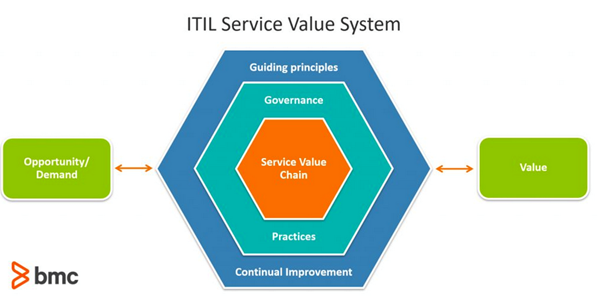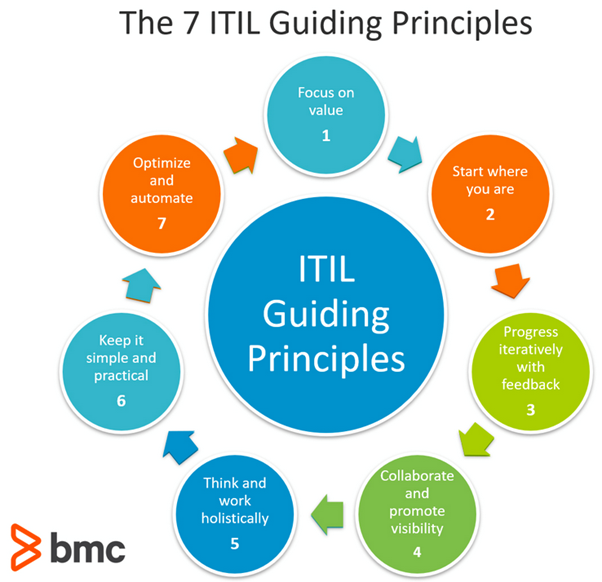Unless you’re brand new to IT service management, you’ll have heard a lot about the new version of ITIL®, known as ITIL 4. You may hear conflicting information about how it differs from the ITIL v3 we know and, possibly, love.
In this article, I am going to clear up this confusion, sharing what’s really changed from ITIL v3 to ITIL 4—and why. Read in full, or head directly to the section you need with the table of contents.
(This article is part of our ITIL 4 Guide. Navigate to other articles using the right-hand menu.)
An ITIL disclaimer
Brief history of ITIL
ITIL’s beginnings
ITIL today
ITIL v3 vs ITIL 4: From “processes” to “practices”
Introduction to ITIL 4: transformation in ITSM
A big ITIL change: The ITIL 4 service value system
Opportunity, demand, and value
Service value chain
The guiding principles
Continual improvement
Practices
Governance
ITIL 4: The 4 dimensions of service management
ITIL 4: The 7 Guiding Principles
1. Focus on value
2. Start where you are
3. Progress iteratively with feedback
4. Collaborate and promote visibility
5. Think and work holistically
6. Keep it simple and practical
7. Optimize and automate
In conclusion
Download Now: ITIL 4 Best Practice e-Books
These all-new for 2020 ITIL e-books highlight important elements of ITIL 4 best practices. Quickly understand key changes and actionable concepts, written by ITIL 4 contributors.
An ITIL disclaimer
Before we wade into the practices and changes in ITIL 4, I want to remind everyone what ITIL is: simply a set of guidelines. A framework that presents the collected wisdom of a lot of very smart people who have been working in service management. These smart people have tried different approaches, sometimes succeeding—and sometimes failing—in creating value. ITIL takes this learned experience, organizing it so that others may extract value from their own IT services.
Conversely ITIL is not something you pick up and “implement”. You pick the parts that work for you, adapt them to how your business works, and constantly improve them. That’s how ITIL efforts become successful.
I find myself constantly nagging on about this because, sadly, ITIL has sometimes received a bad reputation and become a “four letter word”. This is usually due to overly zealous individuals who’ve read the guidance, taken some training, and gone back to work ready to change the world, all in one big bang. When this happens, the initiative will invariably fail and the organization is likely to steer clear of ITIL in the future.
At one organization I worked with several years ago, the manager commented that they had “bought ITIL, but it didn’t work”, and they had no interest in trying it again. Remember: ITIL is merely meant to guide you—it’s not something you can purchase and deploy, in hopes that it fixes your problems.
Brief history of ITIL
Here, I’ll cover a little history to give our ITIL understanding some helpful context.
ITIL’s beginnings
What we know today as ITIL started in the UK in the 1980s. In response to inefficient and expensive IT services serving the UK government, the Central Computer and Telecommunications Agency (CCTA) developed a skeleton framework called the Government Information Technology Infrastructure Management (GITIM).
By the end of the decade, GITIM transformed into ITIL, with the first book published in 1989. Both public and private sector IT departments, searching for structure around ITSM, adopted ITIL. At this point, ITIL was a library of information that outlined the best ways to manage an IT department. Many concepts were taken from IBM’s Information Systems Management Architecture. The library also inspired ITIL’s name: The IT Infrastructure Library. (This name has since been dropped in favor of the simpler ITIL.)
Over time, ITIL evolved into a more formal framework or a set of guidelines for good practice in ITSM. The framework has shifted from being IT-centric to aligning more with business to integrating closely with the business.
ITIL today
We’re on the fourth iteration of the ITIL framework, which is formally owned by Axelos. The latest version, ITIL 4 premiered in February 2019 with a new focus: co-creating value with the business.
Today, as we know, it’s virtually impossible to draw a line where the business stops and IT begins. There’s no such thing as a service that is not, in some form or other, enabled by IT. Managing these services well—ensuring they provide the greatest possible value to the business—is critical. Recognizing this main principle, ITIL 4 maps everything it does back to that main principle: helping the business achieve its vision.
Now, onto ITIL—let’s look at what’s new, what’s different, and what’s stayed the same.
ITIL v3 vs ITIL 4: From “processes” to “practices”
While there are many new concepts, terms, and ideas to look at in ITIL 4, nothing that existed previously has been discarded or disproved—what you learned in ITIL v3 or earlier versions still has immense value. ITIL 4 has simply augmented this value by forcing us to focus on business value rather than simply on technology.
If you ask me, the biggest difference between ITIL v3 and ITIL 4 might be more of a terminology shift than a major structural change. What am I talking about? ITIL v3 processes. When news about the changes from ITIL v3 to ITIL 4 started filtering out to the ITSM community, we had many discussions about the move away from the term “process” in favor of “practice”. Many people didn’t understand why this was happening.
In reality, I think that “processes” was a misnomer in ITIL v3 and earlier iterations. When we talked about the incident management process, we were never talking about a single process. Instead, we were talking about a group of processes and capabilities that allowed us to efficiently manage incidents. ITIL 4 has pulled all these facets together and called it a practice. To me, this makes perfect sense (although it did take a bit of getting used to).
The 34 practices described in ITIL 4 give you what you will need in order to co-create value with customers and stakeholders. The scope of these practices is greatly expanded from the view ITIL V3 gave of its 29 processes—a reflection of significant changes that have impacted the IT industry in recent years. The guidance around these practices recognizes that every organization is different and needs to take approaches appropriate to their own business needs. For this reason, the practices are significantly less prescriptive than previous iterations of ITIL, but they give you the tools you need to begin to improve the value you create with the business.
With that terminology changed cleared up, here’s a breakdown of the ITIL v3 processes and ITIL 4’s practices:

Though some of these practices a new to ITIL 4, it doesn’t mean that we weren’t doing them previously. More likely, those practices were not well-covered in ITIL v3 and previous versions. ITIL 4 has simply taken things that we were already doing and described good practice in these areas.
Introduction to ITIL 4: transformation in ITSM
In my view, ITIL 4 is transformational. The new framework clearly maps the value of the work we do in ITSM to the value we can co-create with the business. One of the biggest conceptual changes in ITIL 4 compared to previous versions: we are no longer talking about delivering value to the business, but working with the business to create the value together.
ITIL 4 introduces us to three key components that, while aren’t totally new, do diverge from the language and structure of previous ITIL versions. These ITIL 4 components separate it from previous versions, and I’ll go into each one in more detail below:
- The service value system
- The four dimensions of service
- The seven guiding principles
A big ITIL change: The ITIL 4 service value system
The core of ITIL v3 is the service lifecycle. In ITIL 4, it is the service value system (SVS) that becomes central. I’ll break down the service value system (SVS) and its six key components, as shown in this graphic:

Opportunity, demand, and value
These are the triggers for everything that a service provider does.
Service value chain
The heart of the SVS, the service value chain is comprised of six interconnected activities that are needed in order to deliver value to customers and realize value for the organization:
- Plan. In this activity, you’ll create plans, policies, etc., that provide the vision of what your organization is trying to achieve, and how you and your colleagues will go about doing so.
- Improve. The improve activity focuses on creating plans and initiatives that enable continual improvement of products, services, and practices.
- Engage. Here, you’ll engage with stakeholders to obtain a clear understanding of their needs and wants.
- Design and transition. This activity results in new and changed services.
- Obtain/build. In this activity, you’ll obtain and build the service components necessary for meeting customer specifications.
- Deliver and support. This activity ensures that the services stakeholders use actually meet their requirements.
The guiding principles
The seven guiding principles provide valuable guidance that can be used to plan and manage IT services and give direction on where improvements can be made. See below for more details.
Continual improvement
Continual improvement must be applied to every component of the service management system, including continual improvement itself. ITIL 4 proffers a continual improvement model that you can apply to all aspects of services
Practices
Practices are the critical piece of the service value chain. Without them, there is no valuable service to deliver. ITIL 4 separates these into four dimensions of service.
Governance
A critical part of the ITIL 4 service value system, governance refers to how you control and direct the IT organization and ensure that you undertake activities that align with the goals and vision of the organization.
ITIL 4: The 4 dimensions of service management
Another concept that ITIL 4 introduces are the four dimensions of service management. Again, these are nothing new, but ITIL 4 articulates them in a simple way that’s easy to understand and action.
The four dimensions represent all the facets you need to think about in order to facilitate a balanced approach to service management. The four dimensions are:
- Organizations and people. The roles, skills, systems, culture, etc., that you rely on to deliver services successfully.
- Information and technology. The technology and information you must have to deliver and manage services.
- Partners and suppliers. The relationships necessary to successful service delivery. Services can no longer be delivered without involving third parties.
- Value streams and processes. The activities, workflows, processes and procedures that are needed in order to provide value.
ITIL 4: The 7 Guiding Principles
To me, one of the most exciting parts of ITIL 4 is the concept of the seven guiding principles. These principles are recommendations that offer universal, enduring guidance to any company or organization. I like these principles because they encourage you to go off-script and adapt parts of ITIL that fit your business. Anytime you’re not sure where to go next, consider these guiding principles—at least one will point you in the right direction.

Let’s look at each of these a little more closely.
1. Focus on value
To put it bluntly: if what you are doing is not providing demonstrable value to the business, then you need to ask why you’re doing it. Often the answer to this question is “because we have always done it”. This guiding principle gives you a valid reason to stop! Everything you do in service management must link back to true business value. Every activity should provide, in some way, progress towards the business achieving its vision.
2. Start where you are
You are (almost) never starting from ground zero. Even if you are building a completely new process, there will be things that are currently being done that will fulfill some requirements that you are working towards. Stop and assess the current state before you begin on a new initiative. Work out where you currently stand and build improvements from that. Don’t start from scratch—instead, always improve on what you already have.
3. Progress iteratively with feedback
As the saying goes “when eating elephant, take one bite at a time”. You need to take small improvement steps, then stand back and assess whether you have achieved what you set out to do. Never attempt zero-to-hero in one bound! Instead, make manageable and measurable changes. Once these are embedded and assessed for value, move on to the next iteration
4. Collaborate and promote visibility
You can’t operate in a vacuum and achieve success. A surefire way to failure: sitting in your cubicle, planning process improvements or other changes on your own, and ignoring the people who will use or benefit from your changes. Get out and talk to these people, understand what they do and why they do it. Work with them to plan improvements, then celebrate your successes and examine your failures together. Step out of your silo and collaborate!
5. Think and work holistically
IT and business are no longer two distinct entities. In a world where all services are IT-enabled, everything we do in service management must contribute to and be part of the wider business ecosystem. Don’t think in terms of servers, applications, or networks—think about that technology within the bigger picture of business value: how do these pieces enable business users to provide value to customers?
6. Keep it simple and practical
Don’t overcomplicate things. Here’s what most people do: design 20-step processes that cover every possible scenario. As soon as you do this, something will change and all your planning will be for naught. Instead, design processes for minimum viability, and teach (and encourage) people to think outside the box when situations arise that aren’t perfectly aligned to your processes. Examine what you are doing currently, consider why you take all the steps you do, ask if these steps provide business value—and when they don’t, stop doing them! I like to say: plan for horses, and if zebras show up, you’ll deal with it.
7. Optimize and automate
Efficient use of precious resources should always be at the top of your mind. Examine your current work processes and explore whether any can be automated. Your human workforce should only be undertaking tasks that cannot be automated, so free them up to concentrate on the jobs that are more complex and more fulfilling. Remember the critical part of automation: you must optimize processes before you automate them; automating an inefficient process often results in less than desirable outcomes
Adoption of these guiding principles throughout the service management organization will result in better collaboration and improved business value.
In conclusion
ITIL 4 is a much-needed refresh of a framework that has been the basis of service management globally for the past 30 years. The focus on co-creation of value and business outcomes takes ITIL out of the technology realm and firmly plants it in the business. With this overview, you’ll be ready to better understand your ITSM—as always, frameworks and technology are never the solution on their own, but they can help solve and improve your IT service management.








